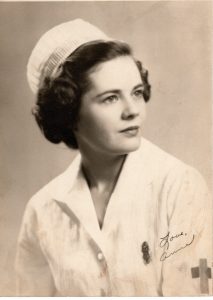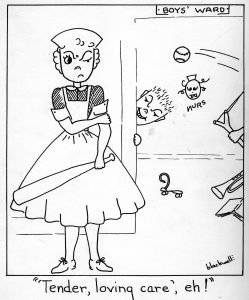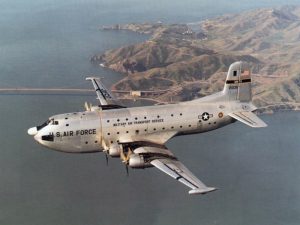I write this with some trepidation – how do you write about your mother? Of course I knew her well, and loved her dearly, but trying to tell her story is daunting. I will tell the story in two parts – from her birth to 1958, and then onwards from 1958.
Anne Banfield Wren was born on September 1, 1917 in the sod hut on my grandfather’s homestead near Keppel, Saskatchewan. She had an older sister, Ethel. She had very few memories of living on the farm, but my earlier post about her father, Jack Wren, describes what I know. In 1922, the family left Canada to return to England. Jack looked for work, but, finding nothing promising, he and the family immigrated to Chicago, settling on the North side near Addison and Broadway.
 Anne went to Le Moyne Grammar school, just east of Wrigley field, then to Lakeview High School on Ashland, graduating in 1936. One of her memories of this period is of having written a paper about the abdication of Edward VIII in 1936, when she would have been a senior. As the resident Brit, she attempted to explain the whole affair in a piece called “A Rag, A Bone – The English Throne”. I’d love to be able to include this little gem, but, alas, it is lost to history.
Anne went to Le Moyne Grammar school, just east of Wrigley field, then to Lakeview High School on Ashland, graduating in 1936. One of her memories of this period is of having written a paper about the abdication of Edward VIII in 1936, when she would have been a senior. As the resident Brit, she attempted to explain the whole affair in a piece called “A Rag, A Bone – The English Throne”. I’d love to be able to include this little gem, but, alas, it is lost to history.
After graduation she attended Armor Tech, which later became part of the Illinois Institute of Technology. In 1941 or thereabout, she started studies to be a nurse at Presbyterian St. Lukes on the near South side. She did not become an RN, but this interlude served as the motivation for a series of cartoons that she drew and published in a Nursing journal (example below). From what she told me, I think being a nurse was intimidating; she told me that she never got used to patients dying. I can relate.
 In 1944, she met my father Richard Quentin (“Q”) on a blind date. One thing led to another, and in April of 1945 they were married in Norfolk, Virginia, where my father was stationed with the Navy prior to joining the Pacific fleet, then preparing for the invasion of the Japanese home islands. And in March of 1946, I appeared , followed by my sister Mary in 1947.
In 1944, she met my father Richard Quentin (“Q”) on a blind date. One thing led to another, and in April of 1945 they were married in Norfolk, Virginia, where my father was stationed with the Navy prior to joining the Pacific fleet, then preparing for the invasion of the Japanese home islands. And in March of 1946, I appeared , followed by my sister Mary in 1947.
I will be writing about my father in a later post. Briefly, after leaving the Navy, he pursued a PhD in biochemistry at Northwestern, and we lived in post-war married student housing in Evanston. The picture below shows me and my sister Mary, at what everyone called the Tin Huts, which were located immediately to the west of Dyche Stadium on the Evanston campus. The families that lived there were taking advantage of the GI Bill. My mother had fond memories of the four years they lived there. They made friends that remained friends for decades.
During this time, my mother had two other babies, Leslie Anne and John Paisley, both of whom died soon after birth. My mother was told that problems had arisen because of a mismatch between her and my father’s Rh factors. Medicine was just learning about this issue, so nothing could have been done. I think that these losses were very hard on Anne – I have a very faint memory of a pretty dark time when I was four or so, and my mother later told me that she had suffered an interval of depression.
 In 1950, Q was a newly minted Asst Prof in the Biochemistry Department of the Northwestern University Dental School, and my parents bought a home on Crain St. in Evanston. Like most mothers of the time, Anne focused on the house and us kids, but by 1955 or so, we were in school, and she was restless; also, Asst. Profs were not paid handsomely at the time. And so Anne went to work. Her first job was working second shift on the assembly line at Sentinel TV and Radio in Evanston.
In 1950, Q was a newly minted Asst Prof in the Biochemistry Department of the Northwestern University Dental School, and my parents bought a home on Crain St. in Evanston. Like most mothers of the time, Anne focused on the house and us kids, but by 1955 or so, we were in school, and she was restless; also, Asst. Profs were not paid handsomely at the time. And so Anne went to work. Her first job was working second shift on the assembly line at Sentinel TV and Radio in Evanston.
This was not what my father wanted. Husbands of that era were supposed to support the family, and wives were to stay home and raise the children. And my Mom was really good at that stuff. She was an excellent, adventurous cook, could sew our clothes, decorate the house, and all the other womanly skills then in demand. She also volunteered as a Cub Scout den mother, and attended PTA meetings. But in a troubling sign of things to come, she volunteered for the then-tiny Democratic Party organization in Evanston, attending the 1952 Democratic Convention at the Amphitheater on Halsted in Chicago, where she actually met Adlai Stevenson.
In 1955, Anne started full-time work as secretary to David Polish, the rabbi at the new Beth Emet Free Synagogue in Evanston. This was an attractive option as the synagogue was just a few blocks away, and Mom could come home for lunch. Over time Rabbi Polish and the people that Mom met at the Synagogue opened up an entire new world for her and for us as well. Mom had never been especially religious, so she was open to this (to her) completely new tradition. The people she met at the Synagogue were very accepting, so the three of us went (occasionally) to temple, shared Passovers, and grew close to several of the families.
We were also by this time attending the Unitarian Church in Evanston. Mom had begun there in 1954, when the church was located on Chicago Avenue, and the pastor was a fairly well-known figure named Homer Jack, who had been an activist, actually having spent time with Gandhi in India. In 1956, this tiny church had the honor of hosting the then little-known Martin Luther King, who was traveling around raising funds for the Montgomery Bus Boycott. (My first bicycle, a red JC Higgins, went to Montgomery in support of the effort).
Now, I just said “the three of us”. What happened to Q? Well, he also worked very hard to live up to the expectations of the time. He was handy, did lots of stuff around the house, exposed me to various male skills (fishing, DIY, etc.), helped out with the other dads with the Boy Scouts, and was very good at telling silly stories to me and Mary. And there were some things that no other dad that we knew could have done. Drawing on his training in chemistry, he put together a show that incorporated various chemical reactions that flashed, burned, banged, fizzed, precipitated, and turned various colors. This show was very popular, and was presented at our school, for the Boy Scouts, and on one unfortunate occasion, in the basement of a local church. In this latter instance, the portion of the show that resulted in an enormous brown “snake” growing out of a beaker, also produced choking sulfurous fumes that caused the coughing crowd to have to exit the basement, quickly. My sister said she would “never forgive” my father for the embarrassment, but of course she did. It was just too good a story.
But, things were not going well between him and Mom. It turned out that she was just as strong and independent as her mother (the suffragette) had been, and her grandmother (the tough little Cornishwoman) as well. My father was not yet able to accommodate these strengths, and so they separated. They alternated over a period of three years between living together and apart. (As discussed elsewhere, my father eventually learned, and profited from having learned, how to treasure another strong spouse).
And so, in 1958, they decided to give it one more chance. My father, who I think was a bit bored with his research, decided to pursue an opportunity with the Navy to set up a research lab in Taipei, described in another post. I think my mother was very attracted to the idea of living abroad. She had been raised with stories about the various generations of Urens and Wrens who had traveled, and I think it must have seemed to be a wonderful opportunity to continue the tradition.
 The trip commenced in July of 1958. International travel, especially with the military, was much more difficult than similar trips would be today. My father was to work as a civilian, but he was still working with the Navy, so he had written orders that served as our “visa” if you will, and we travelled on military transports such as the Globemaster shown to the right, which were decidedly not jets. Taiwan was considered a hardship post at the time, so all of us had to undergo a panoply of shots – Yellow Fever, Typhoid, Typhus, Cholera; I believe there were 12 in all, recorded in a small yellow card to be displayed with the passport for entry. This was before jets, so 8 hours to San Francisco, three days off, 8 hours to Hawaii to stay with friends from the Tin Hut days, and then 14 hours to Tokyo, with a planned stop in Guam, and an unplanned stop in Midway. (One engine out, another engine, according to an older Navy guy sitting behind us, “Not sounding good”). Several days in brown, flat, hot, pre-miracle Tokyo. Pop had been to Japan in 1945, and we managed to get in a little sight-seeing in Kamakura, and a memorable meal, my first real foreign culinary experience – sukiyaki in private dining room in a restaurant on the Ginza, served by a kneeling kimono clad lady. With a raw egg… Hints of things to come.
The trip commenced in July of 1958. International travel, especially with the military, was much more difficult than similar trips would be today. My father was to work as a civilian, but he was still working with the Navy, so he had written orders that served as our “visa” if you will, and we travelled on military transports such as the Globemaster shown to the right, which were decidedly not jets. Taiwan was considered a hardship post at the time, so all of us had to undergo a panoply of shots – Yellow Fever, Typhoid, Typhus, Cholera; I believe there were 12 in all, recorded in a small yellow card to be displayed with the passport for entry. This was before jets, so 8 hours to San Francisco, three days off, 8 hours to Hawaii to stay with friends from the Tin Hut days, and then 14 hours to Tokyo, with a planned stop in Guam, and an unplanned stop in Midway. (One engine out, another engine, according to an older Navy guy sitting behind us, “Not sounding good”). Several days in brown, flat, hot, pre-miracle Tokyo. Pop had been to Japan in 1945, and we managed to get in a little sight-seeing in Kamakura, and a memorable meal, my first real foreign culinary experience – sukiyaki in private dining room in a restaurant on the Ginza, served by a kneeling kimono clad lady. With a raw egg… Hints of things to come.
And so, on we went to Taipei.
